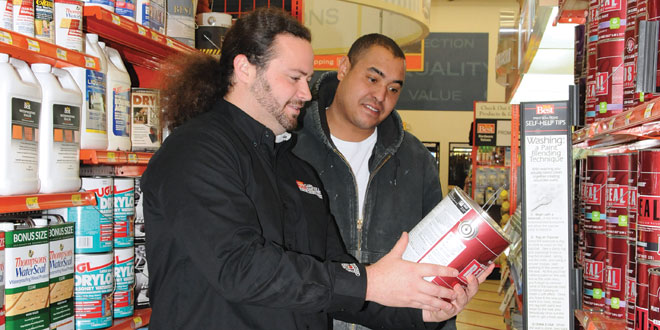This is the fifth in Hardware Retailing staffer Graeme Haase’s series of posts about three days of training that he completed at Cardwell Do it Best Home Center in Indianapolis. Haase went through this training program to get a firsthand account of how a new sales associate’s training goes and to share his experience and impressions with other retailers. See the links below for other posts in the series. To read more about recruiting and retaining high-quality employees, see our story, “Finders Keepers,” in the January issue of Hardware Retailing magazine.
Day 1, Post 1: Preparing for a New Gig
Day 1, Post 2: Wearing Many Hats
Day 2, Post 1: Learning More — and Getting a Workout!
Day 2, Post 2: My Day, Step by Step
Today was the last day of my accelerated training at Cardwell Do it Best Home Center. I brought everything I’ve learned this week and put a big ol’ bow on top.
I felt more anxiety waking up this morning than I did yesterday. Partly because I knew the plan was going to be spending a lot of the day with Bill attending to customers on the floor. Then to add a little more pressure, one of our photographers from Hardware Retailing was scheduled to come take photos of Bill and me. (I’m pretty sure that’s something most employees don’t do during their first week of training!) So, right from the get-go, my morning routine was different. I took extra time to get ready, brushed my mop of hair, ironed my clothes and practiced smiling on command in front of a mirror—all before having my cup of coffee and hitting the road.
Over the course of this experience, I have consumed a lot of information and had a firsthand exposure to procedures and best practices for the very first time. Now that things have wrapped up, it’s bittersweet.
On one hand, I won’t be answering the phone anymore, finding where products are located in the store or worrying about where I park my car—all challenges I’ve faced during this training. But I think about how fun it was learning to cut a key and mix paint, interact with the staff and customers and get a small dose of the inner operations of working in a hardware store, and I know I’m lucky to have had this experience.
I began my last day shadowing store manager Bill Dillow. He showed me some of the steps he takes each week in the store, such as taking inventory, checking for empty racks, using the product gun to scan and take notes of product that is missing or misplaced. He then checks to see if the next bundle has been ordered and if it will arrive with the next truck. This process is not one you want to rush through, and it can take up an entire morning or day (especially considering you set everything aside to help customers).
It doesn’t take an expert in our industry to understand that customer service is the one aspect of a business that sets local hardware stores apart from the big boxes.
Being that this was my first time in retail, I was able to see what giving that extra service to customers looks like, for as each customer entered the store, he or she was immediately greeted by a smiling employee and asked if they needed any help finding something. Sometimes the cashier would help direct the customers; other times, the customer said no thanks. Shortly after, the customer was approached on the floor and asked again if they needed any further assistance. This is where I learned the most important lesson from the day: You can never know enough.
When I approached customers and asked if they needed assistance, I would get questions that were anything from where the plumbing section was located to what types of shingles we had in stock and what they cost to what the best type of paint was to touch up an outdoor shed.
When you work in a hardware store, you’re viewed as an “expert,” whether you are or not. In my case, I am not. I was working on it, but the accelerated training program certainly wouldn’t give me the knowledge I’d have if I did the entire training program and was working in the hardware store long-term. However, I was wearing a Cardwell shirt and was representing the store, and I did my best to answer questions and help customers however I could. I often didn’t have the answers; in fact, I could be seen frequently blushing and retreating to the service desk with a customer to ask someone the same question I was just asked. But I gave it my best shot each and every time, with each and every customer.
Reflecting on my experience, I wish I’d had more knowledge before hitting the floor. But with the time restraint, there wasn’t enough time to utilize other training materials, such as NRHA’s Three Pennies of Profit and Basic Training, that Cardwell uses when training their other employees. Having the knowledge that comes from these videos and other similar training tools will help prepare your employees for whatever questions customers have when they walk through the front door and assure those customers walk out with their questions answered, their products in hand and a smile on their face.
When you work in retail, you’re in a people-driven business, and the staff at Cardwell Do it Best Home Center embraces this idea—it’s a place where the customers truly do come first.
Next:
Day 3, Post 2: What I Learned From Working in a Hardware Store
 Hardware Retailing The Industry's Source for Insights and Information
Hardware Retailing The Industry's Source for Insights and Information







